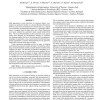Free Online Productivity Tools
i2Speak
i2Symbol
i2OCR
iTex2Img
iWeb2Print
iWeb2Shot
i2Type
iPdf2Split
iPdf2Merge
i2Bopomofo
i2Arabic
i2Style
i2Image
i2PDF
iLatex2Rtf
Sci2ools
126
Voted
ICIP
2010
IEEE
2010
IEEE
Combining free energy score spaces with information theoretic kernels: Application to scene classification
Most approaches to learn classifiers for structured objects (e.g., images) use generative models in a classical Bayesian framework. However, state-of-the-art classifiers for vectorial data (e.g., support vector machines) are learned discriminatively. A generative embedding is a mapping from the object space into a fixed dimensional score space, induced by a generative model, usually learned from data. The fixed dimensionality of these generative score spaces makes them adequate for discriminative learning of classifiers, thus bringing together the best of the discriminative and generative paradigms. In particular, it was recently shown that this hybrid approach outperforms a classifier obtained directly for the generative model upon which the score space was built. Using a generative embedding involves two steps: (i) defining and learning the generative model and using it to build the embedding; (ii) discriminatively learning a (maybe kernel) classifier on the adopted score space. The...
| Added | 12 Feb 2011 |
| Updated | 12 Feb 2011 |
| Type | Journal |
| Year | 2010 |
| Where | ICIP |
| Authors | Manuele Bicego, Alessandro Perina, Vittorio Murino, André F. T. Martins, Pedro M. Q. Aguiar, Mário A. T. Figueiredo |
Comments (0)

